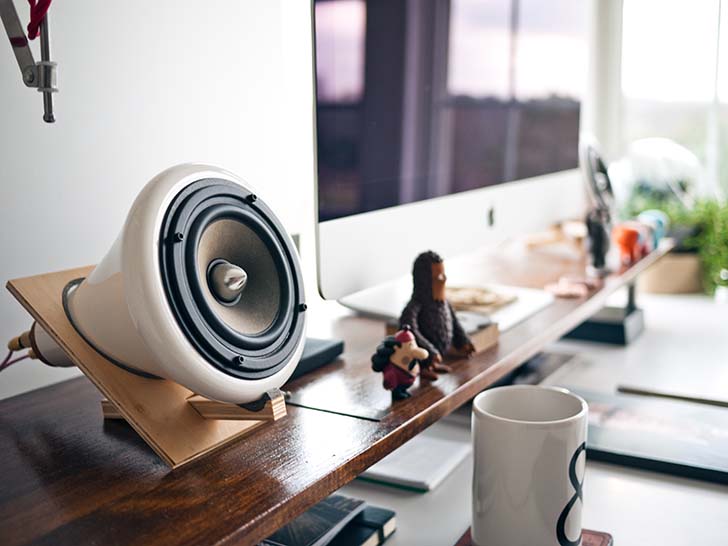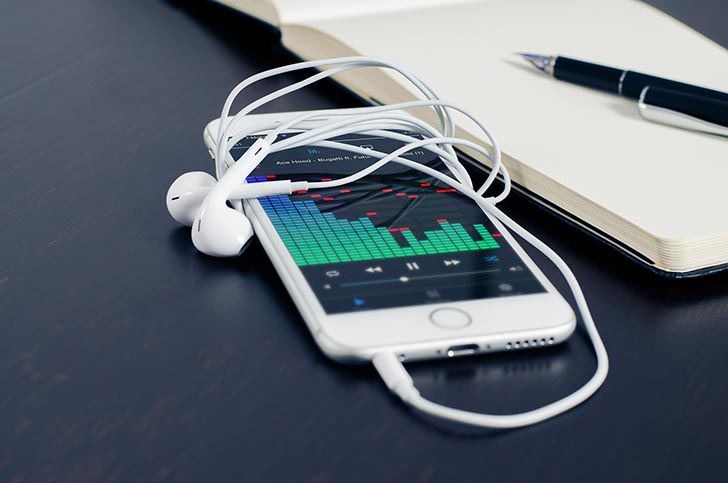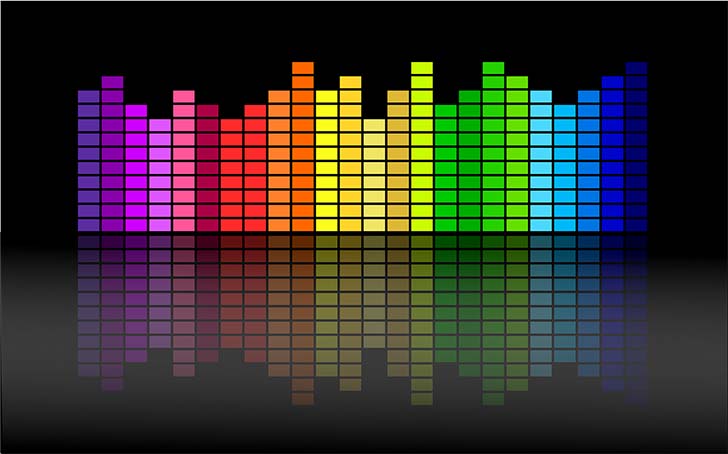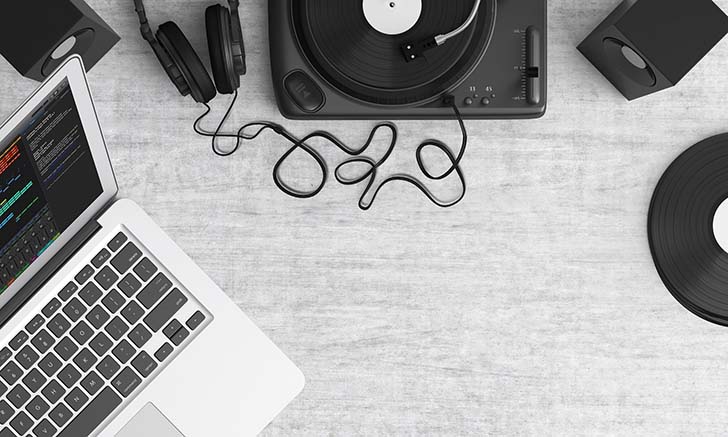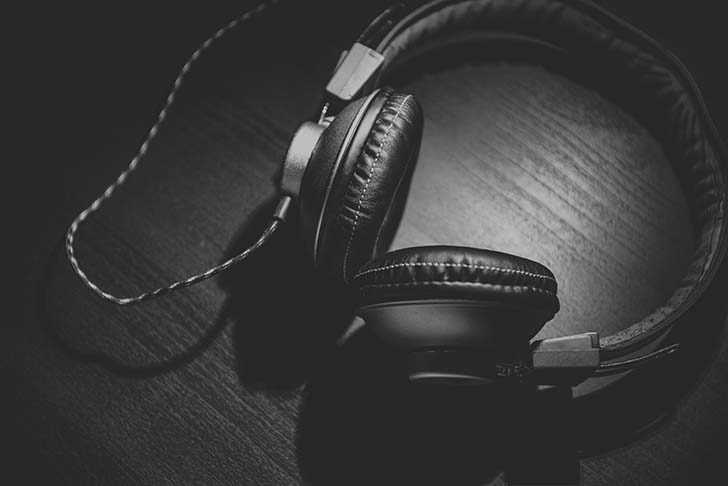Our world is changing, it happens every day, but it is technology and the new ways in which we communicate that are changing our lives so drastically. For example, if we take the music business we can see how it survives by continuously reinventing itself, creating new consumer habits.
The famous heavy metalers of MadridŌĆÖs main street, Gran V├Ła, twins Emilio and Jos├® Alc├Īzar, donŌĆÖt find themselves at number 25 of this iconic street every afternoon by accident. Choosing this specific, concrete point was no coincidence. They have been there since 2005, when they went to protest against the closure of iconic record shop Madrid Rock, which was located exactly where Inditex now languishes comfortably. Big record shops like Madrid Rock have all disappeared yet, at the same time, certain small businesses are surviving, nay proliferating. They base their business on the second hand market, for example selling vinyl to those romantics who still want to feel the physical contact of the music in their hands.
This is how itŌĆÖs looking: According to a report on digital music by the IFPI (International Federation of the Phonographic Industry) in 2015, the sale of physical formats made up 46% of the music industryŌĆÖs total revenue, with countries such as Germany, Austria, France, Japan, Poland and South Africa leading. Even so, in 2014 there was an -8.1% worldwide decline of physical format sales and an -8% decline in download sales. Today, what is more common is a user who, instead of waiting impatiently for the record launch of their favourite group or music to run to the nearest record shop, instead has been transformed into somebody who consumes music compulsively and who is often incapable of listening to an entire song, let alone an album. The 21st century consumer is exposed to such a large quantity of stimuli that holding their attention is becoming increasingly difficult. Now, more than ever, if you donŌĆÖt catch their attention from the first second youŌĆÖre lost. You have to hook the user quickly, be they a reader, spectator or listener.
Music mediums have changed as well. We already mentioned that in just a few decades formats have changed from physical to digital, but today it goes much further than that; the MP3 is losing ground against the new king of the hill: streaming. Diego A. Manrique successfully summed up our relationship with music during the past decades in a recent article for the Spanish newspaper, El Pa├Łs Semanal: ŌĆ£When internet burst into our lives, its offer of a free bar of music proved to be irresistible. You came across friends who are not particularly musical who were suddenly filling up their hard-drives with complete discographies, including those of unknown bands. And normally, that is where they stayed: stored, without being listened to, dead art. The paradigm, as they know, has changed. Accumulating thousands of hours of music lost its charm. Now, we aspire to have all of the music in the world available to us from anywhere by computer or phone.
Effectively, the key is now not to possess and accumulate music but to be able to access it wherever and whenever you want to. This explains the rise in streaming services such as Spotify, Deezer, Google Play Music, or the most recent Apple Music and the controversial Tidal. In the previously-mentioned IFPI report, subscription streaming services are mentioned, along with advertising-supported services i.e. that are free for the user, and already constitute 32% of all digital revenue worldwide. This translates to 41 million users of subscription services, meanwhile the number increases to 100 million if we focus on those that opt for the free version (fremium instead of premium).
The beginnings: We have to make a brief mention of the embryo of this digital revolution. Napster was born in 1999 when some friends decided to set up an MP3 file distribution service where users could exchange music with other fans. The website used a main server but file transfers took place without intermediaries, directly between users. They quickly came across a big problem: copyright. Trials began in which the record labels identified sharing music as theft. In 2001, by court order, they had to close their servers for violating copyright. But that wasnŌĆÖt the end. In 2008 Napster created free.napster.com. At the time it was the worldŌĆÖs biggest MP3 shop, with six million songs, and in 2011 it merged with Rhapsody who claim to have offered the first subscription streaming service. Curiously, the first downloadable song ever was ŌĆśHead FirstŌĆÖ by Aerosmith in 1994. Back then, downloading one song took between one hour and an hour and a half. So yes, you had to be patient and you had to be a big fan.
Distribution: Today, streaming services are completely legal but who really makes a profit from them? It seems that itŌĆÖs the smallest piece of pie that ends up in the hands of the artists themselves, which is where Tidal comes in, a business at the hands of industry bigwigs like Madonna, Jay-Z, Calvin Harris, Kanye West and other heavyweights, who complained that streaming services paid practically nothing to the artists and decided to create their own platform where the fanŌĆÖs money goes directly to the artists, without any intermediaries. It is also a high-quality music streaming service that, unlike the best known services, has no free option, only basic and premium. There are also artists like Taylor Swift who downright refuse to upload their songs onto any streaming services, which is also what Adele did with the release of her new record, ŌĆś25ŌĆÖ. Despite not being available to stream, it sold no less than 2.43 million copies in the United States alone in little more than three days.
Back to the subject of paying, or not paying, the artists, Javier Gayoso, Director of Spotify in Spain, told us: ŌĆ£It is important to understand that listening to Spotify translates to a fee, from the first to the last. 70% of SpotifyŌĆÖs total earnings (advertising + subscription quotas) go to paying artist, label, record company and rights ownersŌĆÖ royalties. Given that our revenue increases with every new subscriber to Spotify, there is no limit to the total of payments that we make. Consequently, there is no fixed rate for listening. Instead, we calculate payments based on the artistŌĆÖs popularity. If an artist represented 1% of the total listens on Spotify, we would pay approximately 1% of the total payment to the royalties of this artist or their representatives. As an exercise in transparency so that artists can understand the payment system, we created a page that explains all of this information: https://www.spotifyartists.com/ŌĆØ. A website that Spotify uses to defend itself from the gossip that circulates claiming that the three big multinationals (Universal, Sony and Warner) had secret contracts with these services in order to distribute the proceeds at their convenience. It does seem that streaming services pay the big labels substantial amounts of money in order to gain access to their musical catalogues. So it seems that streaming, at least for the moment, does yield money but that it goes into the pockets of the usual suspects. Even so, according to the IFPI report, it appears that payments to artists are increasing, especially in countries like Sweden where, in the past five years they increased by 111%, chiefly thanks to the predominance of paid-for streaming services.
The artists: There are two ways to ensure that your music is present on Spotify, Deezer and other similar services. If the artist is on one of the big record labels (we return to the big names) it is very likely that they will already take care of it because they already have an agreement with the streaming service. However, if this is not the case the artist will have to resort to a digital aggregator or distributor. Yep, yet another intermediary who, along with the record company, will end up with another piece of that pie. These digital companies charge a fee for uploading every song or album onto the different streaming services and shops, such as iTunes. They also charge an annual maintenance cost for keeping the music up there and there can even be additional charges for making changes or removing music from the service. Two of the best known ones are TuneCore and CD Baby. In Spain there are also a few, such as Creanauta and Lanzadera Music, to give a couple of examples.
Once a song is finally available for streaming, what does the artist get in return? Monetarily speaking, very little. If we focus on streaming, it is certainly curious that 400 copies of a song on Spotify are necessary in order for them to cough up one Euro. This doesnŌĆÖt go to the artist, but instead to the distributor and the record company, who will then decide what they pay the artist but which, according to calculations, works out at between 0.0054 euros and 0.0076 euros every time we listen to one of their songs. It should also be made clear that for Spotify to pay for a click on a song, it has to be played for at least thirty seconds. Linda Mirada, a Spanish artist, has this to say about streaming services: ŌĆ£They are useful, very useful, to be able to go out onto the street with PrinceŌĆÖs complete discography is priceless, so IŌĆÖm not going to refuse a good service. Whether or not itŌĆÖs a profitable business is something else. In terms of being on these platforms or not… I would say youŌĆÖve got no choice but to do it. You can go with other pages such as Bandcamp, but the majority opt for ŌĆśbeing inŌĆÖ. The problem is that it doesnŌĆÖt work like downloading, where the payment corresponds to the number of times a song is downloaded. The payment system involved in streaming is much more complicated as it is not a direct payment but a distribution that depends on the market quota (where it is easy to imagine who has the biggest slice). If we compare it with the classic model, even they donŌĆÖt know themselves how to calculate how many listens might equate to the purchase of a song. Moreover, streaming services pay the labels, not the artists, and many of the former donŌĆÖt pay the latter. Personally, I have never received any payment for having my songs on these streaming services. The amount must be so insignificant that they donŌĆÖt bother to pay me it.ŌĆØ
Although Linda Mirada, an artist who moves in the independent music scene, has never been paid a cent by any streaming company, Javier Gayoso ensures us that all artists are treated equally: ŌĆ£Spotify has agreements with the three biggest record labels as well as the majority of independent labels. Likewise, artists without record deals can upload their music onto Spotify via one of the digital aggregators that we work with and can monetize their music catalogue in this way. Just as with the big names, Spotify pays copyright to emerging artists every time that a fan enjoys their music.ŌĆØ On the same subject, Leo Nascimento, DeezerŌĆÖs Country Manager for Iberia, says: ŌĆ£The music of independent artists is just as important as that of the big names. In Deezer there is space for all music tastes and we want to continue expanding the music on offer with as many labels as possible from throughout the worldŌĆØ. Space for everybody yes, money for everybody it seems not yet.
One Hit Wonder: Immersed in this over-informed, saturated society, are we returning to the one-hit-wonder phenomenon of groups that we then never hear of again? Do streaming services perhaps promote the model of easy but throwaway success? Leo Nascimento from Deezer sees it like this: ŌĆ£I think that it all begins with a song and that an album should be a compilation of good songs. We live in the ŌĆśattention economyŌĆÖ and an artist can no longer live off a one hit wonder. They need to compose and record good songs, dedicate themselves to promoting them in order to then be able to release an album and go on tour. If their material is good and they know how to connect with the public, they wonŌĆÖt have any problems with getting on the radio and other digital platforms. The quality goes up with higher competition for attention and in the end we all win.ŌĆØ Indeed, portals like Priceonomics recently announced the death of the one hit wonder, arguing that they are increasingly less frequent because, above all, the industry now concentrates more on promoting consolidated artists than new ones. ItŌĆÖs not about finding a hit but instead a long-term career.
Going back to streaming services and this ŌĆśattention economyŌĆÖ that Leo mentioned, itŌĆÖs obvious that the internet has changed the way in which music is consumed and that instead of the one hit wonder we could instead discuss the birth of the one stream wonder, which is no longer a matter of a group or artist with one hit but instead the pre-eminence of listening to a single or hit instead of an entire album. In fact, a recent study conducted by the record label Universal looked at the listening habits of free streaming service users and came to the conclusion that only 10% of them had listened to an entire album. The next question is: Do good songs succeed or is it the best promoted ones? In terms of hits and good songs, Linda Mirada tells us: ŌĆ£We are used to not having to pay for music and this can do nothing but cause overall impoverishment. The ŌĆśhitsŌĆÖ that are released are increasingly gimmicky and I think that in ten years they will be completely forgotten about. In terms of good songs… it depends on what you mean by this but I still think that with the exception of a couple of things every year that somehow find favour, promotion continues to be important. In fact the radio and television continue to have a lot of influence. In terms of streaming services, the campaigns that appear on their websites feature the big labelsŌĆÖ artists and groups. In the end, they are their biggest investors, and the ones who take home the biggest piece of the pie.ŌĆØ
Coexistence of formats? What will happen to conventional and commercial radio? How about physical formats? Will streaming be responsible for their disappearance? We ask these questions to Javier Gayoso from Spotify: ŌĆ£We believe that what we have done is contribute to creating a new source of income for the music industry where it was already exhausting the means of monetisation because of the epidemic that was piracy. In Spain, according to information from the last Promusicae report, the bulk of the digital marketŌĆÖs income comes from streaming, which continues to establish itself. Music sales have increased in the last year by 11% entirely due to streaming. For the first time in our country the record label industry is generating more revenue through digital means than through physical ones.ŌĆØ On the same subject, Leo Nascimento told us: ŌĆ£I think that there is a process of redefining the use of traditional mediums and formats, and that itŌĆÖs clear that they are no longer as relevant as they were in the past. However, I donŌĆÖt believe that they will disappear but instead that they will coexist with the new formats and mediums, meeting the demands of a different type of music consumer.ŌĆØ Even the famous music charts are adapting, little by little, to the times. There are already countries where streaming figures are used to formulate their charts. Another curious piece of information, if we return to the IFPI report: it seems that since mid-2015, both the large record labels and the independent ones have decided to launch their new music on Friday at 00:01┬Āam, depending on the countryŌĆÖs local time, so that all consumers have access to new music at the same time.
The future: As is the norm these days, streaming platforms donŌĆÖt stop reinventing themselves and when we ask them about the future it seems that, according to their figures, it looks pretty promising: ŌĆ£On Spotify we have a catalogue of 30 million songs; we are sure this fact influences the global success of our service. We are now in 58 markets worldwide with more than 75 million active users, of which 20 million have paid subscriptions. In Spain, SpotifyŌĆÖs great success is down to consumer habits and our relationship with technology. Spain is EuropeŌĆÖs leader in smartphone penetration (82% according to Ametic and Accenture). The year 2014 was a year of transformations with a successful transition from desktop to mobile, which has led to new record growth in global subscribers, as well as new features that we have added, such as Spotify Running. Our forecast is that use of Spotify in Spain will continue increasing at a fast rate, both in terms of premium users and fremium users, who are financed by advertising,ŌĆØ says Javier Gayoso.
Regarding DeezerŌĆÖs future, Leo also gives us some figures and news: ŌĆ£We have the biggest global presence. We are available in 183 countries, which enables us to also have the biggest music catalogue (international + local). We have 16 million users and 6 million paying users. Right now we are diversifying the business and going from a music platform to an audio one (music + podcasts), which enables us to develop many other lines of business. We are also involved in some interesting collaborations, which we will shortly be revealing.ŌĆØ Renew yourself or die, because death can also get its grip on this business model; the on demand music streaming service Rdio recently filed for bankruptcy. Other business have also had the same luck, for example Dhingana, a streaming service that was highly popular in India that closed and was then bought, interestingly, by Rdio. Industry experts believe that what happened to search engines and social networks will also happen to these services, that is they will become more concentrated and, in only a few years, out of all these global services, only two or three will remain. Now, what they predict is one thing, what will really happen is another. They also thought that the television would put an end to the cinema and the theatre, and that the invention of the CD would mean crunch time for vinyl. The important thing is that we will always have music, we will take it how it comes and we will consume it how we consume it, be it with a walkman, discman or smartphone… Music non-stop!
Article published on issue 144. If you want to see the whole┬Āissue you can download our apps for┬Ā┬ĀIpad┬Āand┬Ātablets Android. And if you don’t have a tablet you can see it with our┬ĀFree issues visualizer online
┬Ā┬Ā


